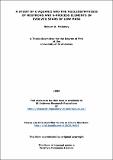Files in this item
A study of U Aquarii and the nucleosynthesis of neutrons and S-process elements in evolved stars of low mass
Item metadata
| dc.contributor.advisor | Hill, Philip W. | |
| dc.contributor.author | Malaney, Robert A. | |
| dc.coverage.spatial | x, 275 p. | en_US |
| dc.date.accessioned | 2014-04-24T15:39:41Z | |
| dc.date.available | 2014-04-24T15:39:41Z | |
| dc.date.issued | 1986 | |
| dc.identifier | uk.bl.ethos.571489 | |
| dc.identifier.uri | https://hdl.handle.net/10023/4604 | |
| dc.description.abstract | The origin of the extreme hydrogen deficiency observed in the R Coronae Borealis (RCrB) stars remains poorly understood. A likely mechanism for producing this deficiency is one whereby the original hydrogen envelope of the star is engulfed and destroyed in its interior. One of the few RCrB stars so far analysed, U Aquarii, in fact shows emphatic evidence of such an event having indeed occurred. This evidence takes the form of the large s-process enhancements observed in U Aquarii. Such enhancements are caused by the production of significant neutron fluxes which are directly produced by envelope engulfment giving rise to the ¹²C(p, γ) ¹³N(β⁺γ) ¹³C(α,n) ¹⁶O sequence of nuclear reactions. In order to obtain vital information regarding the nature of the envelope mixing event from observed s-process enhancements, detailed nucleosynthesis calculations investigating neutron production and s-process synthesis are carried out using a series of nuclear reaction networks and covering a wide range of parameter space. These calculations are mainly based on low-mass AGB and post-AGB stellar models since it is widely believed that the RCrB's are in some way related to this group of stars. It is shown how the ingestion rate of envelope material, the initial abundances and the type of mixing model used have a large influence on the neutron and s-process production. New spectral observations of U Aquarii are presented, and it is shown how these new observations allow a new interpretation of the mixing event which occurred in this star and how further improved abundance data of the star will lead to an unambiguous determination of the nature of the mixing event. The RCrB stars are also thought to be related to the extreme helium stars. Discovery of variability in two of these latter stars is presented. | en_US |
| dc.language.iso | en | en_US |
| dc.publisher | University of St Andrews | |
| dc.rights | Creative Commons Attribution-NonCommercial-NoDerivatives 4.0 International | |
| dc.rights.uri | http://creativecommons.org/licenses/by-nc-nd/4.0/ | |
| dc.subject.lcc | QB806.M2 | |
| dc.title | A study of U Aquarii and the nucleosynthesis of neutrons and S-process elements in evolved stars of low mass | en_US |
| dc.type | Thesis | en_US |
| dc.type.qualificationlevel | Doctoral | en_US |
| dc.type.qualificationname | PhD Doctor of Philosophy | en_US |
| dc.publisher.institution | The University of St Andrews | en_US |
This item appears in the following Collection(s)
Except where otherwise noted within the work, this item's licence for re-use is described as Creative Commons Attribution-NonCommercial-NoDerivatives 4.0 International
Items in the St Andrews Research Repository are protected by copyright, with all rights reserved, unless otherwise indicated.


